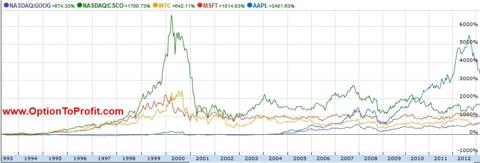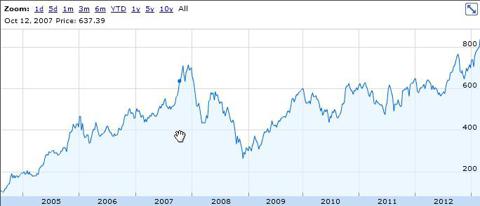 How many times have you heard the expression that “everything is relative?”
How many times have you heard the expression that “everything is relative?”
Certainly, when it comes to the price of anything, on some level a determination is made of its relative value. It can be a complicated process combining objective and subjective measures and is often re-assessed in hindsight.
That latter part is especially true with stock purchases. Buying and selling stocks that should be a simple exercise as you don’t really need to deal with intangibles, such as emotion, fear and the specter of a collapse of the Euro. At least not if you believe that the P/E ratio is a fair measure of value and a simple means by which to make comparisons. It would also helped if absolutely everyone agreed with you in that regard.
Barely a year ago it seemed as if all attention and all excitement was focused on Apple (AAPL) and what kind of price targets it could breach in its unstoppable ride. How often did analysts refer to Apple’s price movement as something unique and special?
As Apple is now having some difficulty living up to those lofty expectations it really shouldn’t come as much of a surprise that it has hit a wall faced by other invincibles of past. Being unique and special is not all that unique if history is a guide. I did my best to suggest that in a number of Apple-centric articles in the past 6 months. While history suggests that Apple will fall even further it gives reason to suspect that Google will march significantly higher.
Let’s go to the charts.
Just look at what happened to some of its sector mates about a dozen years ago. Whether Cisco (CSCO), Microsoft (MSFT) or Intel (INTC), their charts all look very similar. Although the 200,000% increase in shares of Cisco at its peak may be an outlier, Microsoft experienced a 57,000% climb, while Intel and Apple had 18,800% and 21,400% increases from their opening day close trades.
While Cisco, Microsoft and Intel all experienced their high points during the technology bubble, Apple waited the same dozen years to begin resembling the pattern of its Silicon Valley neighbors. Coincidentally, that was the length of time that Steve Jobs was estranged from Apple, before his return following the purchase of Next Computer by Apple.
By the standards of a decade ago, Apple’s share price may still have some way to go to match Microsoft’s 60% drop, Intel’s 74% retreat or Cisco’s 76% plunge. Thus far, with its recent low of $420, Apple has fallen 40% from its 2012 peak. All you need to do is slide its representation on the charts above or below over to the left 12 years and see how nicely they superimposes with the others.
But then there’s Google (GOOG). The company that’s feared, has moved into everyone’s space, is willing to fail, yet somehow garners little respect and attention. Even as it achieved its trading highs, surpassing the $800 level, analysts downplayed the achievement. Instead of discussing the juggernaut that Google is and its expansive vision, the price increase has widely been attributed to people trading out of Apple and into Google. Those are the same people that downplay market rallies by saying that it occurred on light volume. If your banker doesn’t ask about the white powder on your deposits, they’re not likely to ask if they were the result of light volume.
Google simply isn’t really generating the same kind of excitement as Apple did just a year ago. No one has even thought Google deserved an utterance of the “Law of Large Numbers” as a reason why it would have difficulty in continuing its climb.
 Granted, Google didn’t start it’s first day of trading as a sub-$10 stock, so it is a bit more difficult to achieve a 200,000% gain. To do so, its share price would have to advance to approximately $200,000, although it could conceivably split its shares on the order of the 288 fold times that Microsoft has done. While Cisco only had to climb to $22 to increase its share price 100% after it opened for trading, Google had to climb $108 for that distinction. At $838 it is currently up less than 700% from its closing trade on its IPO day in 2004.
Granted, Google didn’t start it’s first day of trading as a sub-$10 stock, so it is a bit more difficult to achieve a 200,000% gain. To do so, its share price would have to advance to approximately $200,000, although it could conceivably split its shares on the order of the 288 fold times that Microsoft has done. While Cisco only had to climb to $22 to increase its share price 100% after it opened for trading, Google had to climb $108 for that distinction. At $838 it is currently up less than 700% from its closing trade on its IPO day in 2004.
700%? That’s nothing by relative standards. That is the poor section of Atherton, barely even good enough to step foot into Palo Alto. Besides, even Johnson & Johnson (JNJ) was able to mount that kind of appreciation in a nine year period beginning in the mid-1980s. By historical standards there’s nothing rarefied about Google’s performance.
Certainly, by no relative measure is Google over-extended. Further, Google’s mettle has been tested and it has shown its leadership qualities. Although Google fell more than the others during the market meltdown beginning in 2007, its descent started later and ended earlier. In fact, Google started its climb back more than three months before the market bottom, having advanced more than 40% in those months preceding the market nadir.
While Apple had out-performed Google in both the periods from the October 2007 peak and the March 2009 bottom, Google has handily beaten the others.
Google’s most recent advance began November 15, 2012, moving forward 20.3%. Coincidentally, the S&P 500’s march higher (13.6%) began on November 15, 2012.
Yet the Google chart looks nothing like that of its one time glorious and subsequently fallen neighbors.
 At this point all it has done is to return and mildly surpass its 2007 peak price.
At this point all it has done is to return and mildly surpass its 2007 peak price.
Once ad click money truly started flowing in Google has always taken the opportunity to try new and exciting ventures, most of which have been scuttled or perpetually stayed in beta. While small in the scope of the enormously growing enterprise, under the leadership of Larry Page the ventures are increasingly bold and increasingly poised to create meaningful revenue streams in addition to the growing annuity that ad click revenue has become. Even if no meaningful or immediate direct revenue is recognized from a venture, Google is a disruptor in the market place and is able to soften the underbelly of a potential competitor. Just ask Apple.
With a growing cash horde and a dividend in its inevitable future, Google has already one upped Apple with its proposed, albeit controversial, stock split. Arguably, the series of stock splits that Microsoft, Intel and Cisco undertook helped to fuel their stock appreciation and Google is still on the ground floor in that regard, standing to benefit from the illusory increase in value.
Most of all, Google is still such a relatively young company that is just learning to walk. Granted, it is doing so during a very different era than did its counterparts, but even by Apple’s modest 18,000% growth, which was not artificially fueled by the technology boom, Google has plenty of room to still return incredible profits to new investors, if it follows the script that has been played out by others.
Finally, I would be negligent, and certainly not mindful of my own history, to not suggest that there are covered option opportunities always available with Google. Although I do not currently own shares, Google has been a frequent source of premium income for me over the past 6 years. With extended weekly options now available as well, there are many choices among strike prices and contract length that both price bulls and bears can find appealing. Even those thinking that there may be no more than an 8% drop by April 20, 2013 can get a !% ROI for their pessimism. For those with a tighter price range the rewards can be substantial if Google stays within that range.
Google is also always an exciting play upon earnings announcement. Of course the premature announcement of two quarters ago was more excitement than many would want to repeat, especially, RR Donnelley (RRD), but Google is a frequent candidate for the “Premiums Enhanced by Earnings” strategy, either through covered calls or put sales, whether its shares move up or down. Seeking to take advantage of its historically large earnings related moves may be a good, and fairly conservative mechanism to find an entry point for those not currently holding shares.
I’ll be looking forward to earnings on April 15th and hope to be in a position to pay a fair share of taxes on the profits the next April 15th.
